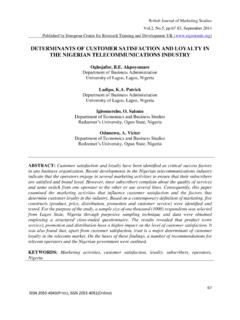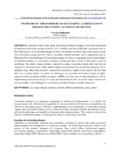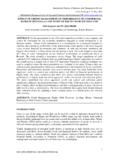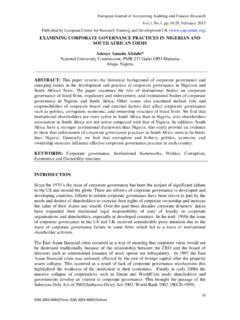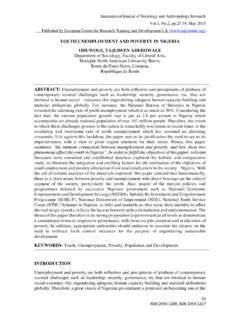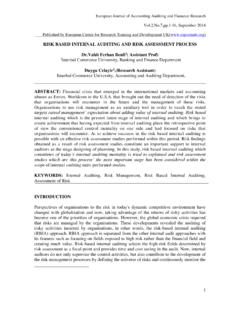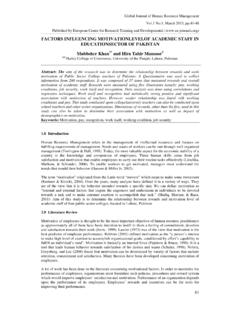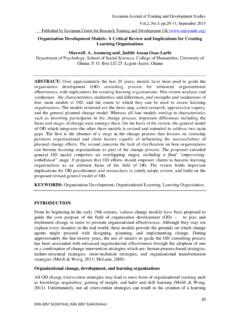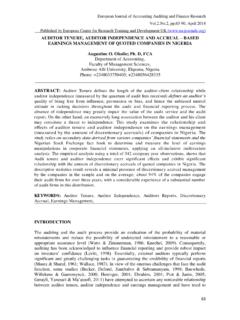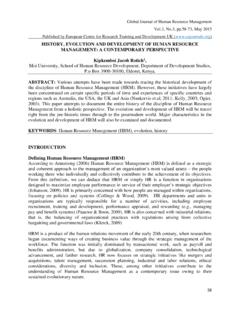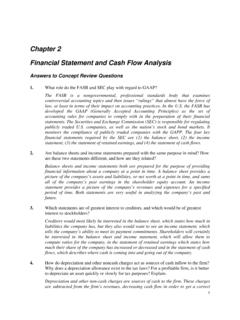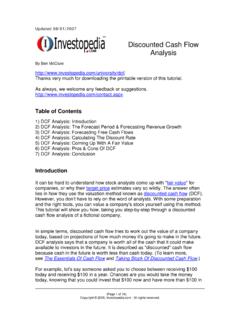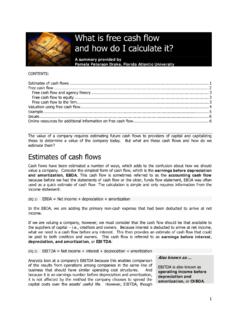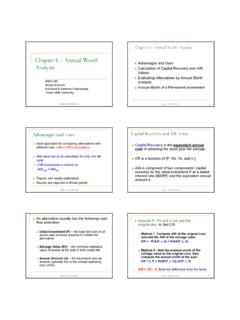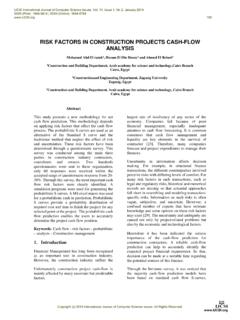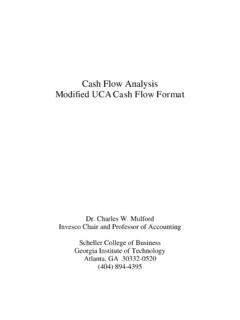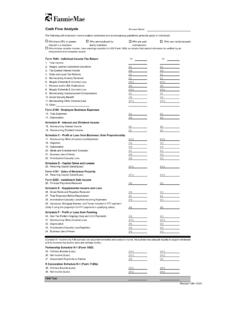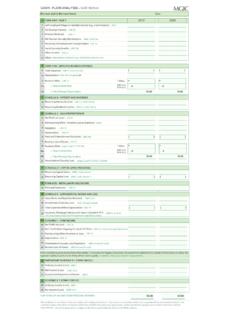Transcription of CASHFLOW AND CORPORATE PERFORMANCE:A STUDY OF …
1 European Journal of Accounting Auditing and Finance Research , , ,September 2014 Published by European Centre for Research Training and Development UK ( ) 77 CASHFLOW AND CORPORATE PERFORMANCE:A STUDY OF SELECTED FOOD AND BEVERAGES COMPANIES IN NIGERIA Bingilar Paymaster Frank Department of Finance and Accountancy Faculty of Management Sciences Niger Delta University 071 Yenagoa. Oyadonghan Kereotu James Department of Finance and Accountancy Faculty of Management Sciences Niger Delta University, Wilberforce Island, 071, Yenagoa, Bayelsa State, Nigeria ABSTRACT: The STUDY examines the relationship between cash flow and CORPORATE performance in the Food and Beverages sector of Nigeria. The STUDY involved a survey of Six (6) Food and Beverages companies quoted in the Nigerian Stock Exchange. Data were obtained from the annual report and accounts of the selected companies under STUDY . The relevant data were subjected to statistical analysis using the multiple regression technique.
2 The results of the STUDY revealed that operating and financing cash flows have significant positive relationship with CORPORATE performance in the Food and Beverage Sector of Nigeria. It was also empirically verified that investing cash flow and CORPORATE performance have significant negative relationship. The researchers recommended that regulatory authorities such as IFRSB, FRCN, CBN, NSE, SEC, NDIC, etc. should encourage external auditors of these quoted Food and Beverages Companies to use cash flow ratios in evaluating the performance of a company before forming an independent opinion on the financial statement. This will give detailed information on the company to enable investors make rational investment decisions. KEYWORDS: cash flow , Operating, Investing, Financing and performance . INTRODUCTION cash flow of a company is a crucial factor that enhances its operations. According to Efobi (2008), Due to the relevance of cash flows in the company s operations and performance , CORPORATE organizations need to develop a suitable cash flow mix and apply it in order to maximize shareholders values.
3 Uremadu (2004) sees cash flows of an organization as those pool of funds that the company commits to its fixed assets, inventories, account receivables and marketable securities that lead to CORPORATE profit. The ability of the company to effectively choose adequate source of funds to fianc its operations will differentiate strong cash flow governance and poorly managed cash flows (Efobi, 2008). For the cash flows to be well structured and effectively utilized, a business firm must be able to devise various ways for selecting the best components of its cash European Journal of Accounting Auditing and Finance Research , , ,September 2014 Published by European Centre for Research Training and Development UK ( ) 78 flows which would be used in the company s operation to raise its productivity or achieve performance . This process should be based on the criteria well drawn up by the finance manager after making a careful financial planning and control for the company (Uremadu, 2004).
4 cash flow is an index of the money that is actually received by or paid out by a firm for certain time period (Albrecht, 2003). This index is not inclusive of non-cash accounting charges such as depreciation. Cash represents the firm s vascular system, if it dwindles, the business will not survive. The fact that a firm is profitable does not mean that it is also solvent. The profit is not cash. The solvency, flexibility and the financial performance of the firm are set on the firm s ability to generate positive cash flows from the operating, investing and financing activities (Turcas, 2011). Cash flows represent all inputs and outputs liquidities and cash equivalents. Liquidities represent cash on hand and demand deposits. Cash equivalents are short-term investments with a liquidity degree that can be easily converted into cash with an insignificant risk of value change. According to Adelegan (2003), cash flows are more direct measure of liquidity and a contributing factor in CORPORATE performance .
5 cash flow information assists its financial statement users in obtaining the relevant information concerning the use of resources of virtually the entire financial resources over a given time period (Ross, et al 2007). Financial statements translate the financial activity of the enterprise into a more or less objective set of numbers, which provide valuable information about the firm s performance and about its possible problems and its potential in the future (Turcas, 2001). The importance of cash flows cannot be overemphasized mainly because the users of accounting information are particularly interested in the cash of the company that is published) in its financial statements (Narkabtee 2000). According to Bodie, et al (2004) internally, managers need to know the current financial position of the firm ( performance and problem), continuing with problems and control functions. According to Fabozzi and Markomits (2006), suppliers are interested in the firm s liquidity because their rights are generally on a short term and in this case the company s ability to pay is best reflected by the liquidity indicators.
6 According to Bragg (2002), investors in bounds, who ordinarily lend the firm on medium or long term for remuneration, are rather interested in the company s ability to generate cash flow for medium and long-term coverage of debt service. It has been argued that there is weak governance of cash flows in the industries and it allows managers to pursue personal goals whereby putting management s interest at odds with the interest of shareholders (Chikashi, 2003; Ali, et al, 2013; Thanh and Nguyen, 2013; Zhou,et al 2012; Watson, 2005 and Ashtiani, 2005) who further argue that cash flows and CORPORATE performance have a significant negative relationship. These arguments have been countered by researchers in related studies such as (Shahmoradi, 2002; Khoshdel, 2006; Adelegan, 2003; Miar, 1995 and Brush, et al, 200), who argued that cash flows and CORPORATE performance have a significant positive relationship. These disagreements among the researchers have created a gap, thus warranting further examination of the phenomenon.
7 The traditional methods of financial analysis that Companies have been using for a long time to assess their financial performance are plagued by a number of drawbacks. The income statement and balance sheet cannot sufficiently evaluate the financial performance of a firm as the cash flow statements have proved to be. It is this situation that necessitated this research work which is aimed European Journal of Accounting Auditing and Finance Research , , ,September 2014 Published by European Centre for Research Training and Development UK ( ) 79 at examining the relationship of cash flow with financial performance in the Food and Beverages Sector in Nigeria. Furthermore, accounting information from both the balance sheet and income statement are also less reliable with regards to the liquid analysis of a Company (Bernstein and Wild, 1999). In the light of the above, the STUDY hopes to serve as a basis to enable shareholders, management, accountants, auditors, investors and creditors to break away from the conventional use of accounting systems for the evaluation of the performance of companies.
8 In their place, the cash-flow statement ratios would be used for performance analysis. Cash flows had to do with operating and investing activities. Operating activities had to do with expenses that do not guarantee a continues inflow of cash. The investing activities on the other hand guarantee a continues inflow of revenue. The issue is how best had these investing activities been evaluated with cash flow analysis or ratios in determining CORPORATE performance instead of the traditional ratio analysis. Several studies had revealed that the traditional ratios are history base such as the balance sheet statement and the income statement which by their nature are records of sunk cost and not relevant for future decision making. Hence this STUDY is to create a basis of directing more research and management application of cash-flow ratios more than the traditional ratios. The broad objective of the STUDY was to examine the relationship between cash flows and CORPORATE performance in the Food and Beverages sector of Nigeria.
9 The specific objectives of the STUDY are as follows: 1. To examine to relationship between operating cash flows and CORPORATE performance in the Food and Beverages sector of Nigeria. 2. To examine the correlation between investing cash flows and CORPORATE performance in the Food and Beverages sector of Nigeria. 3. To examine the relationship between financing cash flows and CORPORATE performance . REVIEW OF RELATED LITERATURE Theoretical Framework This STUDY is anchored on the theoretical framework that cash flows affects CORPORATE performance , and that the extent or degree of that effect, depends on the financing policy, investment policy, accounting policy etc, adopted by the company. Two outstanding theories emerge and present a clear direction and firm behaviour about cash flows (Net-cash flows generated from operating, investing and financing activities). These are Agency cost theory and trade-off theory. According to the agency theory, agency conflicts arise from the possible divergence of interest between shareholders (principals) and managers (agents ) of firms.
10 The primary duty of managers is to manage the firm in such a way that it generates returns to shareholders thereby increasing the profit figures and cash flows (Elliot and Elliot, 2002). According to Boodhoo (2009), the contribution of agency cost theory is that leverage firms are better for shareholders as debt level can be used for monitoring the managers. Thus, higher leverage is expected to lower agency costs, reduce inefficiency and thereby lead to improvement in CORPORATE performance , (Akintoye, 2008). According to trade-off theory, if firms are more profitable they prefer debt financing as compared to equity for the sake of profit. This posture is driven by three forces (Raheman,et al 2007). European Journal of Accounting Auditing and Finance Research , , ,September 2014 Published by European Centre for Research Training and Development UK ( ) 80 1. If a firm has a low profit, there exist greater chances of bankruptcy. So if the firm taken more debts there are chances that it is bankrupt and as a result of this, investors cannot have trust on it.
